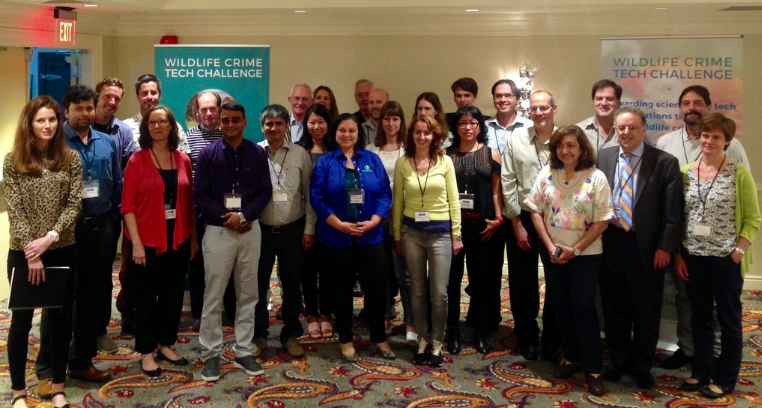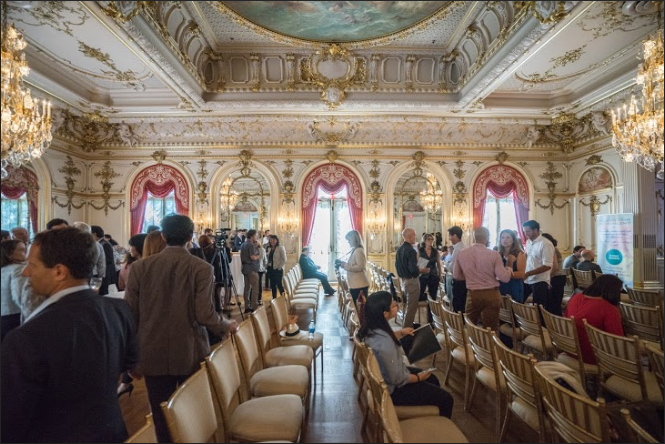Myself and ZSL Technical Specialist Alasdair Davies along with the 15 other prize winners were invited to the intensive three day ‘Accelerator Bootcamp’ in the USA to work on developing our technical solutions.
The energy and talent at the event was incredible. Solutions were diverse and all teams were at the forefront of their field, covering genomics, data science, IoT, security and citizen science.
Technology solutions ranged from a hand held DNA sequencer to intelligent wildlife surveillance systems, with each solution covering different parts of the Illegal Wildlife Trade chain from prevention, tracking and demand reduction, to capturing evidence and prosecuting the perpetrators.
USAID’s careful curation made it abundantly clear how much greater an impact we could have if we all worked together. The teams were very grateful to USAID for bringing the group together to provide essential collaboration opportunities and a springboard for success.

Three days of presentations, workshops and Q&A panels kicked off with an inspiring opener from Claudia McMurray, Challenge Senior Advisor: “We have fought for and won the world’s attention on this issue. The time is now to take fast action and stop wildlife crime.”
Some key themes from the event were:
'We have fought for and won the world's attention on this issue. The time is now to take fast action and stop wildlife crime.' Hon. Claudia McMurray
Partnerships
Angelique Rewers, CEO of The Corporate Agent, facilitated a session on how to leverage influence and build team alliances and strategic partnerships to drive rapid growth. She offered participants indispensable tools and advice to assess and design partnerships, which can create compelling advantage that could make or break success. She focused on how ‘unnecessary complexity creates waste’, with emphasis on how to prioritise and maximise time and resources. The majority of start-up teams in the room were between two to five people – a size where time is your most precious resource and ‘your biggest competition is inertia.’
Securing funding
High profile donors joined the group for a Q&A panel on what donors want and how to engage them. Putting into practice learning from the partnership session, participants asked donors the killer question: ‘What would have to be true for you to invest in my project?’
We were offered three key pieces of advice:
- Alignment. Have you done your research to understand your donor and their interests? Do you understand the donor landscape? Each donor needs a unique approach to align with their individual motivations and interests. A one-size-fits-all blanket approach will not do.
- Scale. Donors want to fund the social tech solutions with clear paths to scale. Asking winners: if successful, where and how will your idea be used in 10 years’ time? Where is the evidence that there is fuel to scale and what partnerships and strategies are in place to prove this?
- Replicate. Philanthropy is difficult to sustain at scale. Donors want to see sustainable funding models where tech can be replicated easily to benefit the conservation community. The panel discussed whether wildlife conservation needs to think more like the private sector to achieve large-scale long-term success? Andrew Currie, Investor, went on to say ‘Not for profit doesn’t mean not making money, it simply means you don’t take profit, so a commercial arrangement to sustain solutions can be seen as a positive.'
The donor panel was very supportive of the social tech startup efforts, recognising that more funding was needed for bespoke conservation technology. Ted Schmitt, Vulcan Philanthropy, echoed this point,‘Technology that is specifically designed for the conservation community is urgently needed. Applying military solutions to the conservation challenge often fails, as these solutions are too expensive, over complicated and do not meet the unique needs of conservation teams and the areas where they work.'
The general consensus was that long term funding commitments are needed to create bespoke conservation technology that is specifically designed for the challenge, and to ensure innovations are fully realised and applied. All were thrilled that USAID is committed to this mission for the foreseeable future.

Scaling
A repeat theme throughout the conference was that technology can only provide the tools and that it is people who will drive real change, with innovations only proving successful when integrated well within law enforcement capacity, communities, cultural norms and policy regulations.
Larrey Cooley, President Emeritus Management Systems International, walked the prize winners through his process for integration and the scaling-up to achieve successful development intervention. This involved looking ahead 15 years and imagining what success looks like, then working back to establish what would have to happen now to make this a reality. This approach encouraged teams to look at specific barriers to scaling and find alternatives to the obvious approach of ‘let’s just push this through harder’. This driving approach typically doesn’t work, as those you are pushing against simply push back harder and nothing moves. Instead, look at those forces opposing success and how you can neutralise these resisting forces to make progress. Are there ways to inspire law enforcement teams? Opportunities to simplify an idea? Or could you examine the influencers needed to see this through?

(Image Credit: Robb Hohmann / USAID)
After an extraordinary week filled with these and many other useful sessions, the time had come for us to take to the stage for the start-up pitches. Tensions ran high as each finalist took their allotted three minutes to convey their ideas with passion and inspiration to a highly engaged crowd.
As we go back to the office, all prize winners took away a disciplined focus on how to disrupt the status quo, to plan strategically, and an even greater passion to drive real change.
As the solutions move into their next phase of development, we all look forward to collaborating and working with our new network of supporters.
Thank you USAID, and Challenge partners TRAFFIC, National Geographic and Smithsonian for a well run programme, a fantastic event and a great opportunity for wildlife.
To find out more about ZSL's prize winning project, Instant Detect, visit their site. To discover more about the USAID Wildlife Crime Tech Challenge prize winners, visit the Challenge site or download their new winners profile book.
About the Author
Sophie Maxwell leads the Conservation Technology Unit at ZSL. She brings years of experience from the commercial sector leading teams from across the global to develop innovative products and services for blue chip brands. ZSL’s technology team develops new technology solutions to solve conservation challenges across wildlife monitoring, protection and public engagement platforms.


Add the first post in this thread.